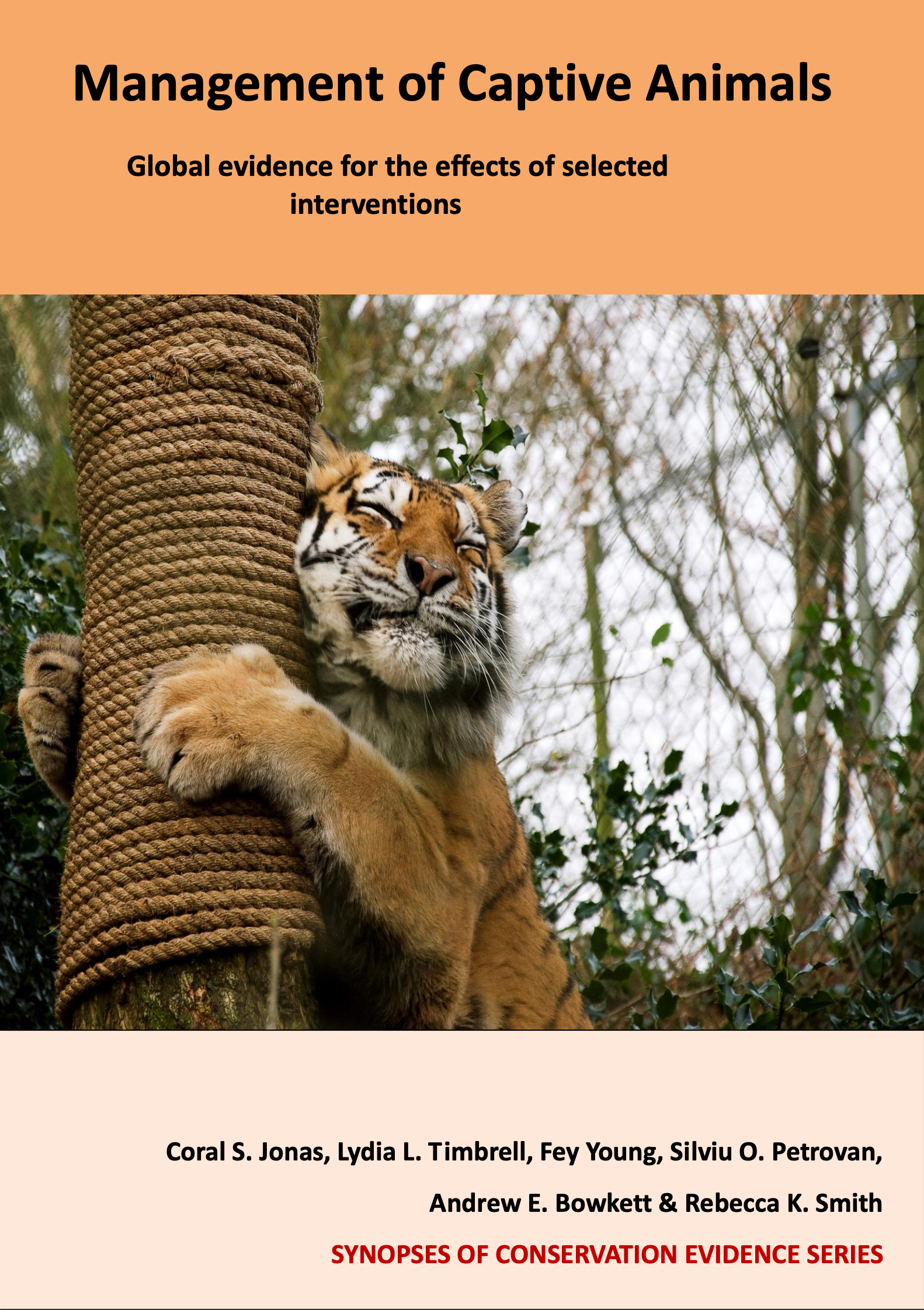Actions to conserve biodiversity
We have summarised evidence from the scientific literature about the effects of actions to conserve wildlife and ecosystems.
Review the evidence from the studies
Not sure what Actions are? Read a brief description.
Search for evidence
e.g. "frogs chytrid"
96 Actions found
Refine
Hide
96 Actions found
Download Actions
| 0 selected |
|
Order results by:
| Action | Effectiveness | Studies | Category | |
|---|---|---|---|---|
|
Amphibians: Supplement diets with carotenoids (including for colouration) Action Link |
Unknown effectiveness (limited evidence) | 1 |
|
|
|
Amphibians: Supplement diets with vitamins/ calcium applied to food (e.g. dusting prey) Action Link |
No evidence found (no assessment) | 0 |
|
|
|
Amphibians: Supplement diets with vitamins/ calcium fed to prey (e.g. prey gut loading) Action Link |
No evidence found (no assessment) | 0 |
|
|
|
Amphibians: Use artificial cloning from frozen or fresh tissue Action Link |
No evidence found (no assessment) | 0 |
|
|
|
Amphibians: Use artificial fertilization in captive breeding Action Link |
Trade-off between benefit and harms | 4 |
|
|
|
Amphibians: Use hormone treatment to induce sperm and egg release Action Link |
Trade-off between benefit and harms | 17 |
|
|
|
Amphibians: Vary artificial rainfall to simulate seasonal changes in the wild Action Link |
Unknown effectiveness (limited evidence) | 2 |
|
|
|
Amphibians: Vary duration of enclosure lighting to simulate seasonal changes in the wild Action Link |
No evidence found (no assessment) | 0 |
|
|
|
Amphibians: Vary enclosure humidity to simulate seasonal changes in the wild using humidifiers, foggers/misters or artificial rain Action Link |
No evidence found (no assessment) | 0 |
|
|
|
Amphibians: Vary enclosure temperature to simulate seasonal changes in the wild Action Link |
Unknown effectiveness (limited evidence) | 2 |
|
|
|
Amphibians: Vary food provision to reflect seasonal availability in the wild Action Link |
No evidence found (no assessment) | 0 |
|
|
|
Amphibians: Vary quality or quantity (UV% or gradients) of enclosure lighting to simulate seasonal changes in the wild Action Link |
Unknown effectiveness (limited evidence) | 1 |
|
|
|
Amphibians: Vary water flow/speed of artificial streams in enclosures for torrent breeding species Action Link |
No evidence found (no assessment) | 0 |
|
|
|
Carnivores: Allocate fast days Action Link |
Unknown effectiveness (limited evidence) | 1 |
|
|
|
Carnivores: Alter feeding schedule according to visitor activity Action Link |
No evidence found (no assessment) | 0 |
|
|
|
Carnivores: Alter food abundance or type seasonally Action Link |
No evidence found (no assessment) | 0 |
|
|
|
Carnivores: Change location of food around enclosure Action Link |
Unknown effectiveness (limited evidence) | 1 |
|
|
|
Carnivores: Feed a plant-derived protein diet Action Link |
Unknown effectiveness (limited evidence) | 2 |
|
|
|
Carnivores: Feed commercially prepared diets Action Link |
Unknown effectiveness (limited evidence) | 5 |
|
|
|
Carnivores: Feed individuals separately Action Link |
No evidence found (no assessment) | 0 |
|
|
|
Carnivores: Feed individuals within a social group Action Link |
No evidence found (no assessment) | 0 |
|
|
|
Carnivores: Feed whole carcasses (with or without organs/gastrointestinal tract) Action Link |
Trade-off between benefit and harms | 6 |
|
|
|
Carnivores: Hand-feed Action Link |
No evidence found (no assessment) | 0 |
|
|
|
Carnivores: Hide food around enclosure Action Link |
Beneficial | 6 |
|
|
|
Carnivores: Increase variety of food items Action Link |
No evidence found (no assessment) | 0 |
|
Download Actions
| 0 selected |
|

Management of Captive Animals - Published 2018
Captive Animal Synopsis
Watch this search
If you are familiar with RSS feeds, please click the button below to retrieve the feed URL:
RSS feed for this searchIf you are unfamiliar with RSS feeds, we would suggest reading this BBC article.
Unfortunately, due to the number of feeds we have available, we cannot provide e-mail updates. However, you could use tools such as Feed My Inbox to do this for you.
What are 'Individual studies' and 'Actions'?
Individual studies
An individual study is a summary of a specific scientific study, usually taken from a scientific journal, but also from other resources such as reports. It tells you the background context, the action(s) taken and their consequences.
If you want more detail please look at the original reference.
Actions
Each action page focuses on a particular action you could take to benefit wildlife or ecosystems.
It contains brief (150-200 word) descriptions of relevant studies (context, action(s) taken and their consequences) and one or more key messages.
Key messages show the extent and main conclusions of the available evidence. Using links within key messages, you can look at the paragraphs describing each study to get more detail. Each paragraph allows you to assess the quality of the evidence and how relevant it is to your situation.
Where we found no evidence, we have been unable to assess whether or not an intervention is effective or has any harmful impacts.





)_2023.JPG)














